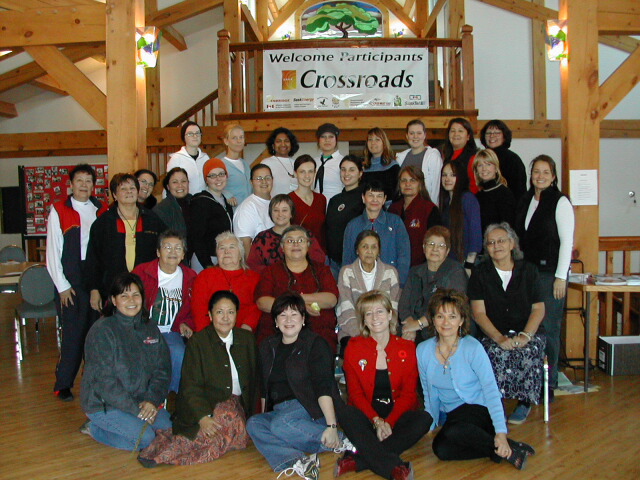
Crossroads
We piloted Crossroads in 2000 in Calgary and due to its success, reproduced it annually over the next five years in Winnipeg, Edmonton, Saskatoon, Yellowknife and then back to Banff, Alberta with a focus on youth. In retrospect, the concept was revolutionary, bringing sixty Aboriginal and non-Aboriginal women from Calgary and area together for a weekend long “sharing circle” to explore the challenges and opportunities facing urban Aboriginal youth. The theme was not as important as the gathering itself. This was a first. All but a few of the participants had ever had a meal with a woman from the other culture. We were in every sense foreign to each other even though, geographically, we were neighbours.
It took nine months to plan with an extraordinary team of courageous women from both cultures who committed to understand each other, exercise patience with each other’s cultural idiosyncrasies and unconscious biases, calmly point out insensitivities, all united in the common goal of finding common ground. This is where I had my first taste of art and experience as a powerful tool for profound change. Our cross-cultural committee was appropriating what Indigenous people have known and lived for millennia – art, design, creation is in everything.
Quoting from Gerald T. Conaty in the preface to Honouring Tradition – Reframing Native Art:
“Art has always been an integral part of Native People’s lives. It was interwoven with the production of tools, the construction of dwellings, and the manufacture of clothing. While European cultures separate art as a practice that is distinct from most aspects of daily life, First Nations people have a more holistic understanding of the world. Visual art has always been integrated with song, dance, ceremony, and oral traditions. In these cultures, it is not possible to speak of art; art is part of everything. “
Over the weekend, we came to know each other through sharing meals, art, dance and stories. But first we had to “break the ice” as the Westerners would say. Would we do something with name tags? Play a game? We wanted to create an interactive activity that would establish trust and encourage the women to get to know each other, and one that would establish a theme that could be carried through the weekend and beyond. We landed on “talking sticks” – a symbolic branch decorating activity. Carol put the suggestion forward and as with all elegant solutions, the positive outcomes are innumerable and unpredictable.
On arrival, all the participants sat in a large circle. In the middle of the floor was a basket with a number of branches from a fruit bearing tree, each carefully harvested and pruned by Carol’s husband, an arborist, and later blessed by an Elder. The concept of the talking stick in Aboriginal culture was explained, how it was passed from one person to the next in a sharing circle. If you had the stick, you could speak or not speak and for as long as you needed. We would use a talking stick in sharing circles throughout our sessions.
Carol also spoke of the strength of the group versus the individual by demonstrating how easy it is to break one stick, but if you hold five or six in a bundle, it becomes impossible. She spoke to the symbolism of uniqueness (each being different), of strength (all together, they couldn’t be broken), of womanhood (fruit-bearing trees), and of community (part of a whole). The branches united the women during the weekend and continue to serve as a reminder of their personal and group commitment after the event, a memento of our learnings.
After each participant handpicked her stick from the basket, we distributed small containers of colored ribbons, beads, feathers, strips of hide, small silver jingle bells. Our task was to take the weekend to decorate our stick, and take it home as a memento of our learnings.
We spent the next fifteen minutes meeting each other by “shopping for our supplies”. I smiled as I watched the Indigenous women circulate, knowing exactly what they were looking for, the others in new territory, with trepidation but open to the adventure. This, I realized later, was perhaps the first time the non-Indigenous women felt at some level that there may be more to learn from the people who had been here for millennia. Through the creation of something together, through humility, bonds were being forged, braided, like sweetgrass.
Full report on the conference:Crossroads 2000